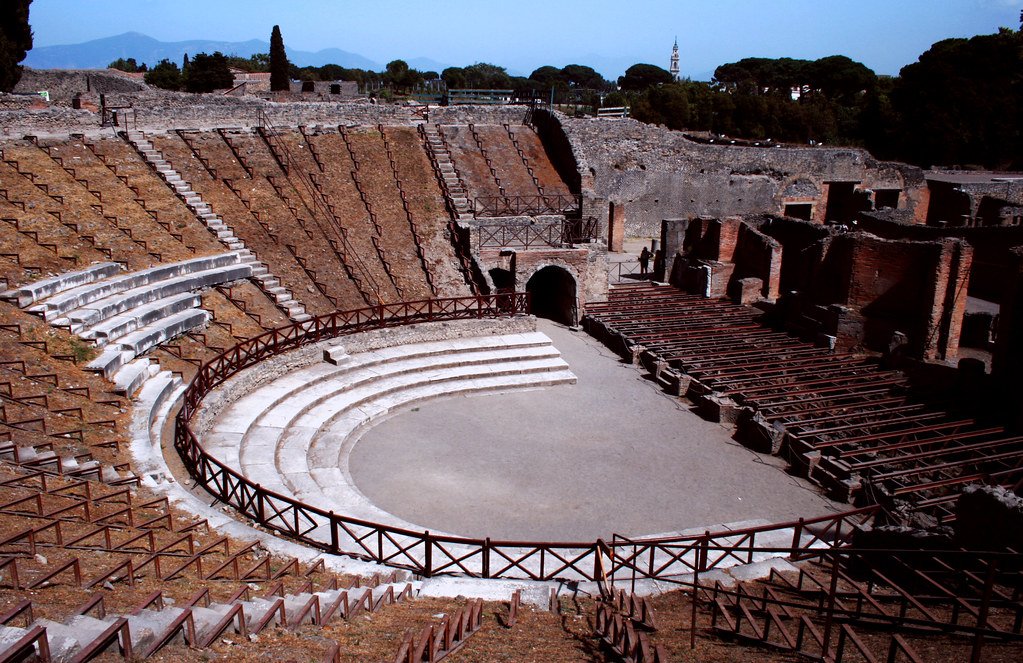
Pompeii a city in the region of present-day Campania, Italy. Over the years, the city has experienced two disasters. First an earthquake and then a volcanic eruption.
Today, Pompeii is one of the most visited cities in Italy. Tourists want to see historic buildings. There are lots of monuments here.

Vesuvius Volcano
Volcano Eruption

August 24, 79 CE the Vesuvius volcano erupted. The explosion destroyed Pompeii. About 1,200 people or even more died then. They were never rebuilt and fell into oblivion for centuries. Pompeii was rediscovered in the 17th century. Archaeological works were proof of this.
Pompeii is still one of the most famous excavation sites in the world. Currently, about three-fifths of the city has been discovered. Excavations have been going on there continuously for several centuries.
The most important problem is not the discovery of new objects, but the conservation of already discovered monuments that are deteriorating.
What Survived?
Forum

Forum in Pompeii (Foro Civile de Pompei)
The forum in Pompeii was a large square for public use. Political, religious and commercial life was vibrant here. Today there are the ruins and skeleton of the forum, a magnificent ancient structure. Broken columns and cracked facades remind us of magnificent temples, fountains and ornate arches. You can imagine all this while looking at the ruins and distant Vesuvius.
In the square you can see countless jugs and pottery. We will also find there the first plaster casts of bodies, which were made immediately after the decomposition of the victims’ bodies.
Villa

Villa Dei Misteri – Villa of Mysteries, Pompeii
Villa of Mysteries ( Villa Dei Misteri) is a well-preserved Roman country estate on the outskirts of Pompeii. The villa was buried as a result of a volcanic eruption and excavated in 1909. This building is popular for its first-century frescoes in one of its rooms. The frescoes depict a lady who reveals the secret of Greco-Roman religion.
Temple of Apollo

Sanctuaire d’Apollon, Pompei
The Temple of Apollo has undergone changes over the years. It is worth knowing that it is the oldest building in Pompeii. The beginnings of construction, i.e. the 6th century BC. until its destruction in 79 AD, the first, original design was changed by the Greeks and then expanded by the Romans.
While most of the temple’s original statues are now in the National Archaeological Museum of Naples, in their place stands a copy of Apollo and a bust of the goddess Diana.
Amphitheater


Amphitheater in Pompeii
The Roman amphitheater in Pompeii was built in 70 BC. and is the oldest facility of this type that has survived to this day. Characteristic external stairs led to the upper stands. The amphitheater was originally built of wood, but later a stone structure was built. The facility measures 135 by 104 meters. Gladiator fights, sports competitions and animal fights took place here.
Lupanar

The Lupanar, or Municipal Public House, was located on two levels, with five small cells on the ground floor and five on the first floor. Each cell had a stone bed. Each cell had an erotic fresco on the wall.
Termopolium

Termopolium, Pompeii
Thermopolium was a street bar that was popular in Greek or Roman cities among the poor who could not afford their own kitchen. A typical thermopolium consisted of a small room with a long stone brick counter. Such a counter had clay jars in which fried and prepared food was placed.
Grand Theater and Little Theater

Teatro Grande – Grand Theater
The Teatro Grande (Big Theatre) is an open-air amphitheater where Greco-Roman plays were performed. The smaller Odeon housed cultural events, poetry and musical performances, which required a smaller and covered space to achieve the best acoustics.

Teatro Piccolo – Little Theater ODEON
With so many amazing artifacts and a stunning landscape, it’s well worth a trip, and it’s the perfect place to take kids to show them the history of Pompeii. Beautiful, although not perfect, buildings will really interest you.
